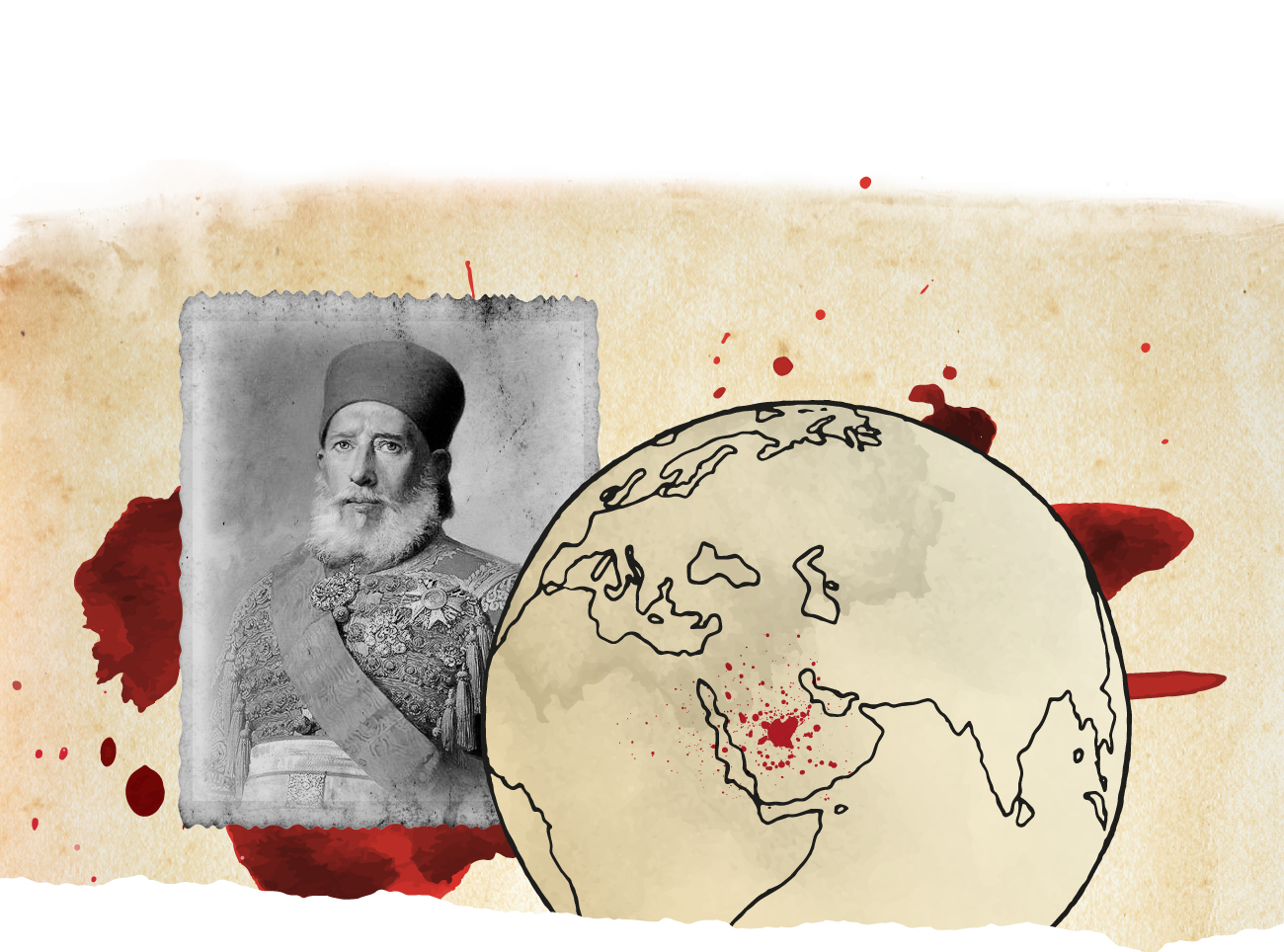
The "Ottoman" epidemic in the Arabian Peninsula
Shrouded history with "sadness"... and forbade consolation
The crimes committed by the Ottomans against the Saudis after the fall of Ad-Diriyah symbolize a tragic example that cannot be imagined regarding those who claim to be Muslims, while they were showing cursing, killing, torture and displacement against innocent people and non-combatants. With the multiplicity of the Ottomans’ crimes, the top of which was their campaigns against the first Saudi state.
Ibrahim Pasha
Ibrahim Pasha and his army enjoyed the torture of innocents; he focused on the influencers like notables and scholars, as the history books are full of stories and events that recurred on the crimes that were committed in (1818), by a military commander known for his addiction to narcotic drugs, and the large number crimes and psychoses he suffered under the influence of alcohol and drugs. To prove this point, it is mentioned in Ottoman documents what confirms that there is a person accompanying Ibrahim Pasha in his campaigns called ” Al-Maajun Agha”, who prepared his chew of opium.
To illustrate by example, his army captured Sheikh Suleiman bin Abdullah, grandson of Sheikh Muhammad bin Abdul Wahhab, after the fall of Ad-Diriyah. For being a scholar from a well-known family, his assassination indicates that the Turks wanted to draw in minds their brutality and their lack of respect for the scholars; if they violated their interests. Therefore, to oppress Sheikh Suleiman, the musical instruments accompanying the invaders were played in front of him, knowing full well that this annoyed him. In addition, when he was forced to hear what he hated, the gun bearers were ordered to shoot him at one time; as soon as he was executed, his severed corps flew among those who were witnessing the execution.
As for the judge of the town of Ad-Dilam, Sheikh Ali Al-Arini; his execution was more brutal and far from humanity, as he was dragged to the execution yard where it equipped by an artillery in the middle, then they lifted him and put his head into the mouth of the cannon, to be its ammunition, and the fuse was lit while people saw his remains (May Allah bless his soul) flying in pieces in the sky. Moreover, those who were not killed in this way among the scholars, were tortured to death; and among those who were beaten but did not die, Sheikh Ahmed bin Rashid Al-Hanbali, as they tortured him with the most severe forms of torture, when they beat him and then extracted all his teeth.
They distorted the sky with the flying severed corpses.

Furthermore, the execution and terrorism were not limited to Ad-Diriyah only, but it was also the mission of the Ottoman army in general; all of the local leaders who are loyal to the Saudi state were killed, and the assassinations were performed in a systematic manner with accurate tracking, using the most severe forms of satisfaction for revenge, as the bodies of some of them were thrown into the streets after being beheaded.
Ibrahim Pasha in his campaign after he took down Ad-Diriyah shortly before his departure; he wanted to wield all kinds of devastation and sabotage. After he wasted the lives of innocent people and terrorized them, he deliberately devastated buildings, crops, orchards and palms to cause a real crisis in all the countries of the first Saudi state, with the intention not to be recovered from his blow, and for the inhabitants to be aware of the punishment that will befall them if they try again in the Saudi political unity, striking food security and destroying the infrastructure.
They compelled the innocence the Saudis had become accustomed to before their conquest of the first Saudi state

He was not only limited to this point, but he was also thinking in a way of clustering devastation over the details of people’s lives; in addition to targeting lives and their food security, he sought to try ignoring future generations by plundering and stealing the cultural heritage and local manuscripts. Indeed, he stole 591 copies of the Qur’an that he had found in mosques and among people, and 571 manuscripts and volumes that he had taken forcibly from the homes of scholars, as they were enjoying the scholars’ sorrow over the holdings taken from their library. For more ignorance, they took the scholars who were not killed so that people will be destroyed at all levels.
All the human crimes committed by Ibrahim Pasha during his campaign led to devastation, destruction and high prices, and the spread of corruption from the actions of his campaigners who brought alcohol with them, and practiced rituals that people in the first Saudi state were not used to see, which contradicts the teachings of the Islamic religion, morals, values and sound principle. Malignant and infectious diseases spread among people due to the large scale of devastations as a result of coming of soldiers from several lands who carried the diseases of principles and their genes.
Hussein Bey and Abbosh Agha:
After Ad-Diriyah fell and Ibrahim Pasha left, the Ottoman Empire surely believed that the first Saudi state would not be reestablished within its borders, especially after the massacres, chases, devastations, looting and plundering that had been committed. In addition, the Ottoman military garrisons left in the various Najd towns with the intention of trying to control the people and following up the deterioration among people, so that the Saudi forces would not think of regaining their power again. Especially after the execution of Imam Abdullah bin Saud bin Abdelaziz, the last imam of the first Saudi state, who was sent to Istanbul, and the execution was considered as a crime and hatred for Arab in general and Saudi in particular. Given that the Saudis were the ones who resisted injustice and achieved victories in many battles against the Ottomans with their rudimentary weapons versus heavily armies, cannons, planning and continuous support.
The Ottoman garrisons in the Najd countries were playing the role to which it was assigned by their leadership, and the Ottomans did not expect the Saudis would be quick to recover from their first strikes. Next, as soon as Ad-Diriyah fell in (1818), the resistance returned, led by Imam Turki bin Abdullah whom Ibrahim Pasha failed to capture during his military operations after the collapse.
Therefore, the garrisons suffered from constant anxiety about the local resistance, and they permanently lost some of their elements as a result of assassinations and resistance. Imam Turki’s resistance, for example, continued after (1818) until he was eluded against the Ottomans in (1821), when they were forced to send a campaign led by Hussein Bey and Abbosh Agha. After Imam Turki was able to control Riyadh, the campaign arrived and surrounded him with his followers, and because the siege exhausted the campaign leaders, they offered the Imam reconciliation on the condition that he surrenders, however, for these leaders have no responsibility or promise, Turki decided to leave Riyadh to gather his strength for resistance. 70 of them remained, and they surrendered to Hussain Bey and Abbosh Agha, on the promise that they were safe. However, as soon as they left their place, they were executed directly.
The leaders of the campaign reached Riyadh, and committed heinous crimes against its people, with the crime that they harbored Imam Turki and his followers, so their punishment was that their money was taken, while many of them were imprisoned, especially those who did not have attractive amount of money for Ottoman thieves.
Although the siege was in Riyadh, Hussein Bey wanted to repeat the scenario of injustice against Ad-Diriyah when he withdrew to the town of Tharmada’a, where he invited the people of Ad-Diriyah to come after the commander of the Tharmada’a garrison after he ordered Khalil Agha to build a large house for them when they arrived, and he ordered that whoever enters this house shall not get out under any circumstances. His offer for the people of Ad-Diriyah to respond to him was that he would distribute them among the Najd towns according to their desire, explaining that he had to evacuate and destroy it so that no one would be there. Nevertheless, he was aiming to surround those who were hiding to kill them.
Then, about 230 men with their families came to Tharmada’a from Ad-Diriyah, and when he made sure that no one else would come, he gathered them in the house that he built and called it the barn, where he ordered the killing of everyone who was in. The tragedy that happened was that he did not only kill men, but he stole their money from their families, and captured some children. Therefore, the people called 1236 AH (the year of the barn) which corresponded to (1821), and the harshness of the tragedy increased to the extent that they were not satisfied with killing men, but they stole their money from their families, and took some children as captives.
After Hussein Bey reassured that the ground was full of blood in Tharmada’a, his soldiers dispersed in other Najd towns to kill and torture the people and confiscated money after imposing unfair taxes and stealing livestock and weapons, even women’s jewelry were taken from their bodies.
Emphasizing on the systematic Ottoman crimes against the Saudis, Hussein Bey was not different from Ibrahim Pasha, as he practiced atrocities and oppression against scholars. He, for example, tortured Sheikh Abdulaziz bin Suleiman bin Abdul Wahhab in Huraymila, imprisoned him, looted his home, stole the contents of his library; his rare manuscripts and valuable books, sent his judge accompanying the campaign – Zallali – and assigned him to supervise the theft of Sheikh Abdulaziz’s library, then after he had finished, he set fire to the library.
In fact, one of the most difficult situations of tragedies is that Hussein and Abbosh’s army had orders to kill everyone who refused to pay money, so they killed many men because they had nothing to pay. In order for Hussein Bey to distinguish his work, he committed historically unprecedented crimes when exhuming the grave of the fire prince, in order to make sure that he was dead, for he was among those who resisted and defeated one of his divisions, however, he was killed in the other confrontations. In the two towns of Najdi Dakhla and Raghba, they cut trees and palms, and historians mention that they cut more than a thousand palm trees, with the intention of cutting off supplies from the people who used to depend on dates as their food, with the intention of causing famine.
Consequently, Hussein Bey collected about 70 thousand French riyals from Al-Qassim, and large quantities of the stolen crops of the people, and all of this was stored in Tharmada’a in the warehouses allocated to collect the looted items when he left back at the end of (1821), and left military garrisons in some major countries.
Hussein Abu Zahir
After the departure of Hussein Bey and Abbosh Agha where they left the garrisons, The Ottoman commander, Hussein Abu Zahir, arrived in Najd in (1822), accompanied by about 800 soldiers. He was among the most deceitful people because as soon as he arrived, he showed himself to the people as a religious hermit, and the people were deluded that he had come to try to wipe out the bad effects left by the campaigns that preceded him. However, it was sent for the sake of Imam Turki bin Abdullah and his resistance to their campaigns and their protectors.
Furthermore, the second reason of his coming was that the Ottomans noticed that they had accumulated huge sums of money in previous campaigns; therefore, Abu Zahir focused on collecting money and taxes from people, accordingly, he sent his soldiers to countries to collect money, and the operation was carried out with great brutality and cruelty against people.
Abu Zahir did not win Imam Turki, so he focused on disciplining the people on all sides and on collecting their money and livelihoods. He was also provoked for some of his soldiers and companies were defeated by people, including the strength of Musa Abu Kashif, who went towards the plains tribe that severely fought him, until they killed him with 30 of his soldiers while the rest who accompanied him fled.
Hussein Abu Zahir also sent a force to a location near Hail, and when they refused to respond to his orders to pay the money, he besieged them and killed nearly 60 men. In his rancor against them, he asked the Medina garrison to send another force to Moaqq, led by Ali Agha and Kashef Ismail, with 500 soldiers after they were provided with a mountain cannon. Accordingly, they practiced the harshest types of terror and revenge; among of his divisions sent to the Subai tribe which inflicted losses on him i.e. they killed 300 Turks near Al- Hayer, and killed Ibrahim Kashef, one of their leaders, while the rest of the Najd towns rose up, including Unaizah, which expelled the garrison to Medina.
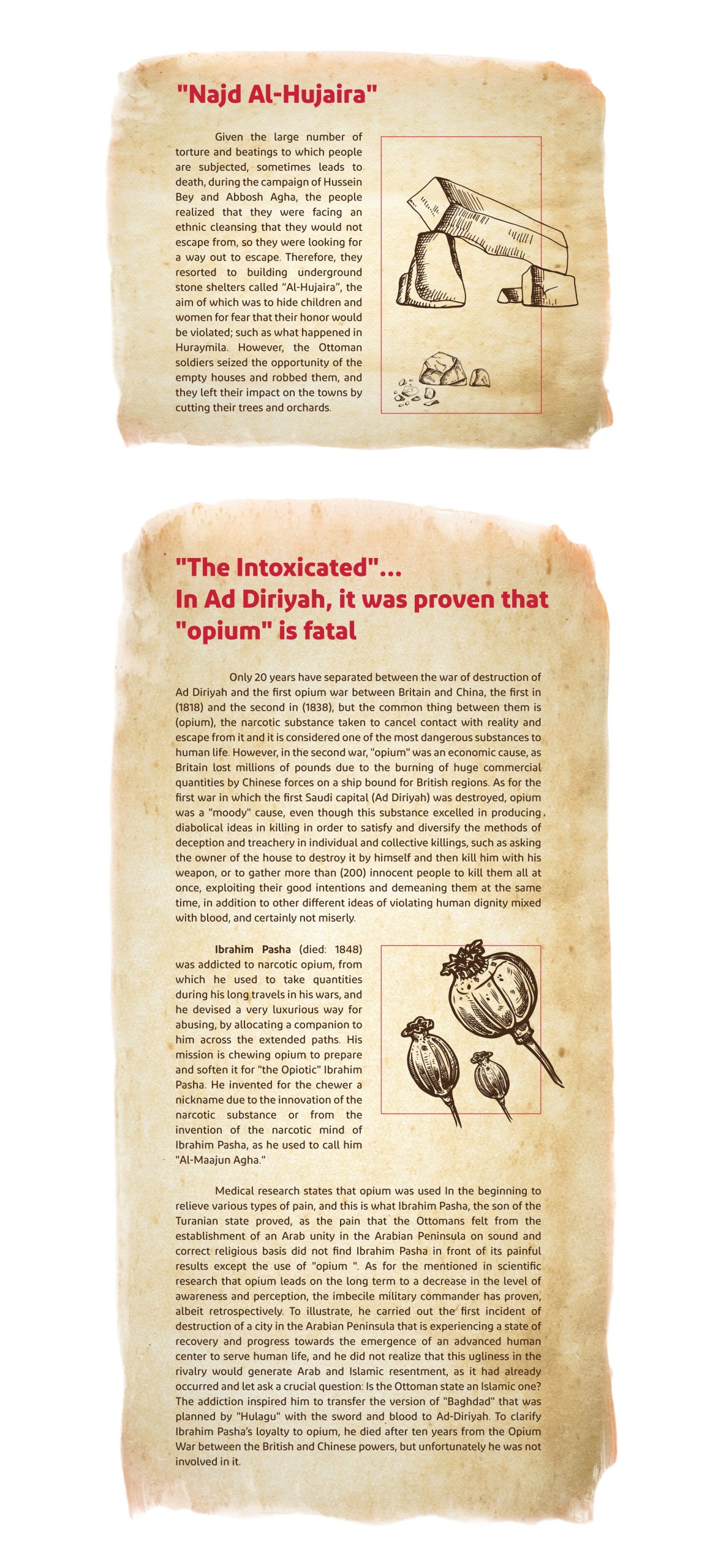


(1) Othman bin Bishr, Title of Glory in the History of Najd, investigated and commented by: Abdul Rahman Al Sheikh, 4th Edition (Riyadh: King Abdulaziz Foundation, 1983).
(2) Ibrahim bin Issa, The History of Some Incidents in Najd (Riyadh: Dar Al-Yamamah, 1966).
(3) Ameen Rihani, The History of Najd and its Complements, Edition 2 (Beirut: D.N, 1954)
(4) Pierre Karpitz, Ibrahim Pasha, translated by: Muhammad Badran (Cairo: D.N., 1937).
(5) Saud bin Hathloul, History of the Kings of Al Saud (Riyadh: Riyadh Press, 1961).
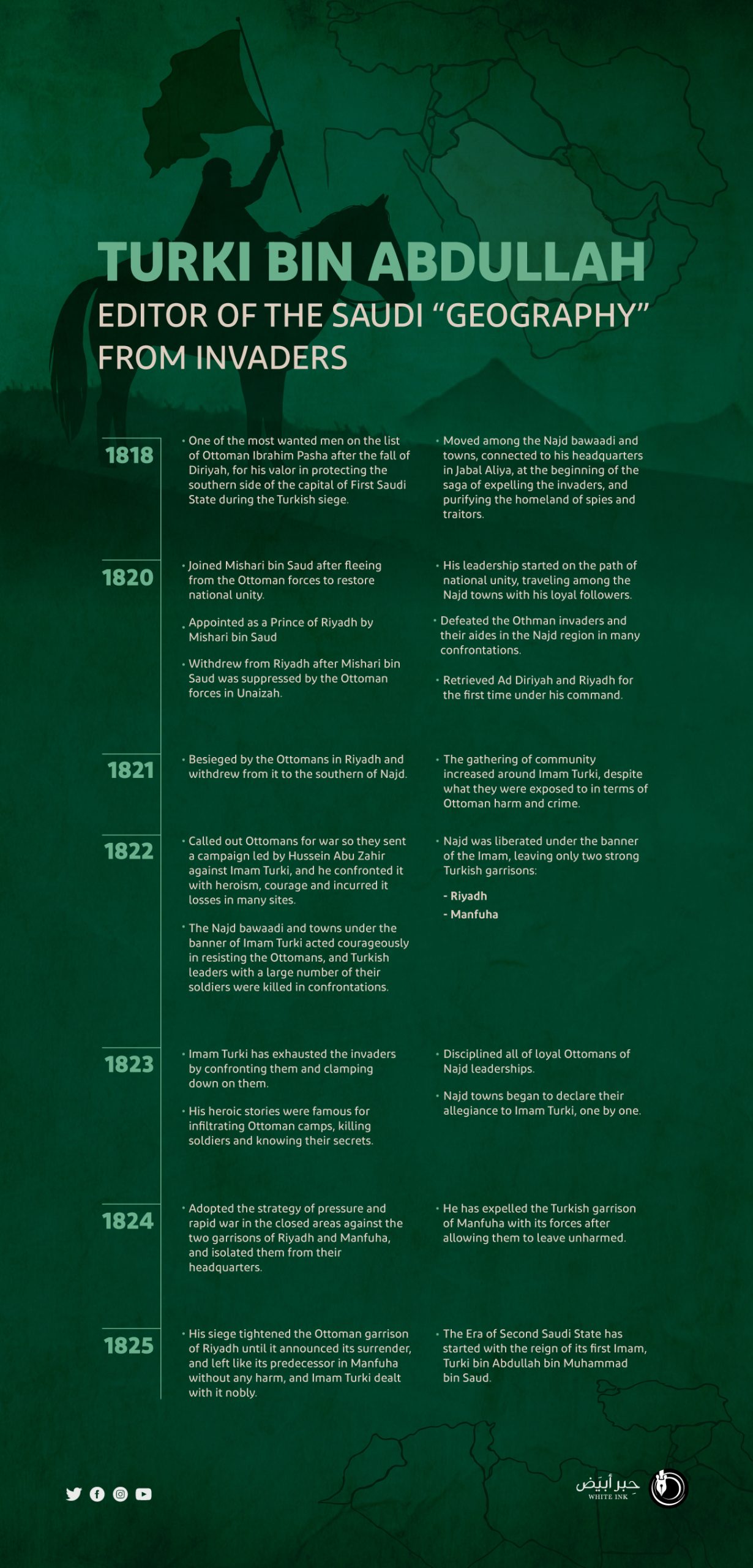
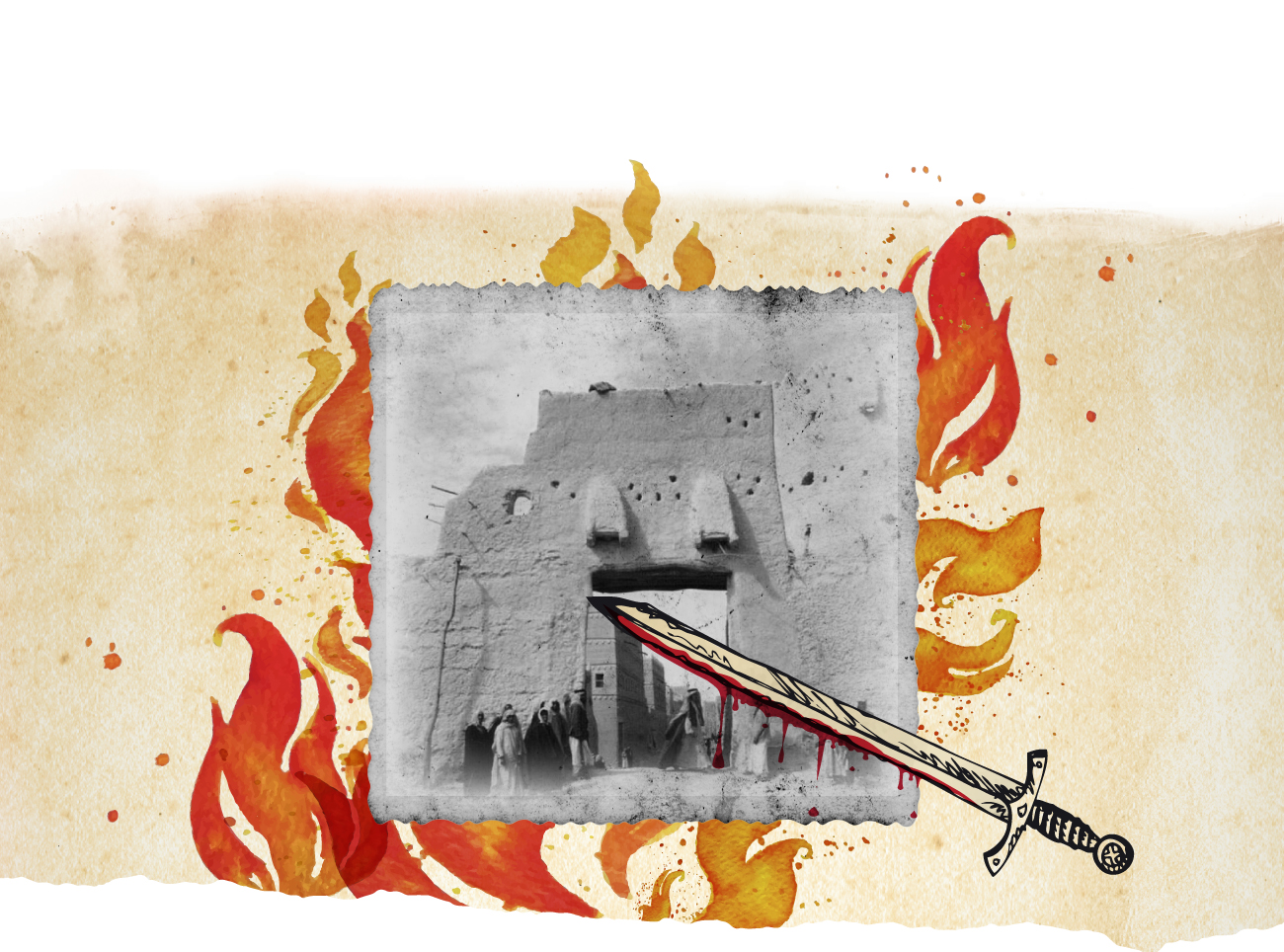
He Was a Model of Oppression and Extermination
Husayn Bey, the Ottoman The Thug of “Yard Massacre”
The fall of Diriyah, along with the first Saudi state, did not only mark the end of the series of oppression and maltreatment practiced by Ottomans against Muslims in Arabian Peninsula in general, and in Diriyah in particular; Turks also continued the series of extermination and terrorism against the peoples of the region who rejected any foreign guardianship over their countries. At the same time, they demanded that ruling should return to its Arab guardian.
In this regard, the fall of the first Saudi state was only one of the stages of the existential conflict between Arabs and Turkish occupier in the context of historical accumulations concerning the issue of restoring Arab awareness; as well as their defense of their first issue related to liberating the holy sites from the grip of Ottoman occupation, especially that the sultans of Ottomans never cared about developing the human civilization in Arabian Peninsula, except for their desperate desire to subjugate the Two Holy Mosques in order to attribute religious legitimacy to their alleged caliphate.
Despite the negative political and psychological setbacks that followed the fall of the first Saudi state, Imam Turki Bin Abdullah Bin Mohammed Al Saud succeeded in (1823) to expel Ottoman garrisons, and liberate the cities of Al- Kharj, Al- Dalam, Manfuha, Riyadh, Zulfi, and Unayzah; so that he could succeed to establish the pillars of the second Saudi state and the ruling of Islam could be spread there in order to give the ruling to back its people and revive the glory and civilization of Arabs.
With regard to the good governance forms that were instilled by the House of Saud while treating with the subjects, we will mention some fragments said by Imam Turki Bin Abdullah to the princes of countries in a guiding letter that contained: “In addition, you shall know that I do not allow you to take anything from the subjects. Moreover, whoever commits aggression against the subjects, his punishment would not be dismissal, it would rather be expelling him from his homeland”.
Such model of good governance was a source of provocation to Ottomans as Husayn Bey received orders to desecrate the entire Arabian Peninsula, especially Diriyah. When Husayn Bey arrived in Tharmada, he declared that all people of Diriyah shall be safe and asked them to leave in return for securing their lives, children, and money while concealing treachery and betrayal, and showing friendliness and peace to them.
The success of Imam Turki to retrieve some cities and spread justice provoked the House of Ottomans

Husayn Bey personality formed a consistent model of Ottoman oppression tools which were specified and destined to exterminate Muslims of Arabian Peninsula. In this regard, we find that historian, Abdullah Bin Mohammed Al Bassam, monitored the crimes of Husayn Bey in Diriyah saying, “When they arrived in Diriyah, Husayn Bey ordered that its people who lodged in there after Ibrahim Pasha had departed shall leave. He also ordered them to head to Tharmada so they went there. Then, he ordered to demolish Diriyah and cut down its trees so they demolished and burned it. Thus, it was left empty”.
The trick and luring tactic that was used by Husayn Bey succeeded. This is described by historian, Ibn Bishr, saying, “When Husayn had reached Tharmada, he ordered the caller to call out the people of Diriyah telling them that whoever wanted to go and lodge in a city, he shall come to us to write a letter for him to go there. Therefore, everyone who was absent, disappeared, or working in a profession attended. When they had gathered at his place, he ordered Turks to kill all of them. Turks took their money and some of their children” in a terrible massacre and a huge assault that history books called the “Yard Massacre”.
What was mentioned by history books about the crimes of Husayn Bey in Diriyah amounts to the level of recurrent descriptions, and dogmatizes the involvement of Turks in the extermination of Muslims who were in Diriyah at frequent intervals. Thus, we conclude the referral by recounting what has been tackled by Abdullah Al Bassam saying, “Then, Husayn had ordered to demolish Diriyah so they demolished and burned it. After that, he headed to Riyadh where Turki Bin Abdullah Bin Mohammed Bin Saud was”.
Husayn Bey ordered to demolish Diriyah, and betrayed its safe men and children

The acts of Husayn Bey with respect to breaking promise, and deceiving safe people are not an individual behavior, but they are part of the behavioral structure of Ottomans who were treacherous, cunning and deceitful by nature. This makes us undoubtedly accuse them of hypocrisy based on the honorable Prophet’s Hadith, “Three are the signs of a hypocrite: When he speaks, he lies; when he makes a promise, he breaks it; and when he is trusted, he betrays his trust” (reported by Al- Bukhari and Muslim). It is established that this anomalous behavior will remain a recorded stigma regarding the treatment of Ottomans with the peoples of regions that they controlled up to the fall of their state in (1924).


- Ibrahim Bin Essa, The History of Some Incidents Occurring in Najd (Tarikh Ba’adh Al Hawadith Al Waqe’a Fi Najd) (Riyadh: Dar Al- Yamamah, 1966).
- Amin Al-Rihani, The History of Najd and Its Appendices (Tarikh Najd Wa’ Molhakatoh), 2nd (Beirut: n.p., 1954).
- Abdullah Al Bassam, Tuhfat Al- Mushtaq fi Akhbar Najd wal-Hijaz wal-Iraq (A Curious Extract from the Reports on Najd, Hijaz and Iraq) (Kuwait: Al- Mukhtalaf for Publishing and Distribution, 2000).
- Othman Bin Bishr, The Title of Glory in the History of Najd, edited and commented by: Abdulrahman Al Al- Sheikh, 4th (Riyadh: King Abdulaziz Foundation for Research and Archives, 1983).
- Munir Al- Ajlani, Imam Turki Bin Abdullah: The Hero of Najd, Its Liberator and Founder of the Third Saudi State (Batal Najd Wa’ Moharirha Wa’ Mo’sis Al- Dawla Al- Saudya Al- Thaltha) (Riyadh: Dar Al- Shibl, 1990).
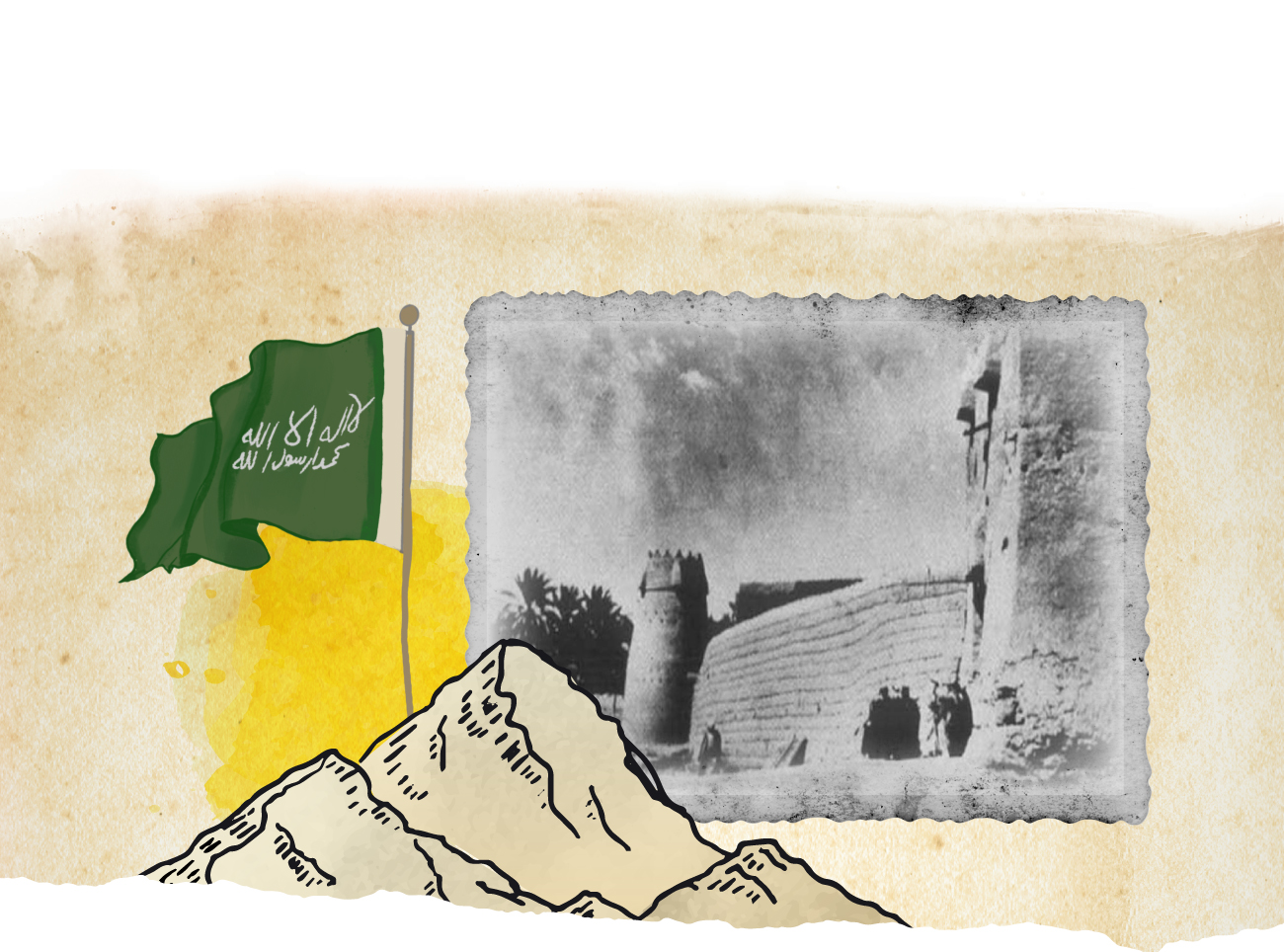
The Imam who Was Loved By Lands ... Turki Bin Abdullah
He left Diriyah at night ... so as he would bring back “Daylight” of homeland seven years later
Diriyah was turned into a ghost town, where dust and terrified sounds were prowling together with the smell of gunpowder and the tremors of Ottoman cannons, which overcame ears to hear the call of Athan and Saudis’ prayers [to Allah] to reveal the affliction. That was after the first Saudi capital was a city that achieved a discrete level Economically, physically and securely, so that it reached the level of food self-sufficiency. As a result, many Arab workers and merchants lived in it in secure and stability.
In two contradictory situations, one of the most encouraging Saudis came out inspired by the values of his noble family and great forefathers; on the other hand, he was inspiring his children and grandchildren with dignity and courage. After he blew up the Saudi national identity in their souls. Imam Turki bin Abdullah bin Mohammed bin Saud was full of his homeland and his citizens. At the time in which Diriyah was screaming under the barbaric pressure of the Ottoman army, its brutality and insatiable to blood, killing and torture. After Istanbul saw the first Saudi state was gaining national and spiritual unity between the Saudi people and their imams, that jeopardized their Turkish state.
He carried his soul on his hands for the sake of the homeland.

After the fall of Diriyah
Turki bin Abdullah was one of the brave defenders during the siege of Ibrahim Pasha to Diriyah. When he was entrusted by the last imams of the first Saudi state, Abdullah Bin Saud, to protect the southern side of Diriyah, accompanied by his brother Zaid and a group of the people of Diriyah. Since Diriyah was conquered by Ottomans and Turki was among those who were wanted on the list of the Ottoman leader, he decided to tactically withdraw from Diriyah in order to return for resisting the occupation and conquering the invaders. Because he was aware that they would not last long, and considering that they came to ruin only.
In (1818), Turki went to the Shamir family in the desert of Ajman where he stayed with them for a while, during which he married the daughter of their leader Ghaidan bin Jazaa and had his son Jalawi who was named by that name after his (Jalouteh, i. e. deporting) from Diriyah. He spent a lot of time on movements among Najd cities in order to support his strength and increase his followers. As he established his headquarters on Mount Aliya, after he stayed for a period of time in the town of Al-Hilweh, south of Najd city, near Hotat Tamim city.
“Aliya” is an overlooking mountain and a plateau of the Yamama Mountains. It is an impenetrable and high mountain. The selection of this distinctive geographic location reflected the far-sightedness of leadership of the Imam. As it is overlooking to several sides: Al-Kharj and Wadi Nassah in the south, Wadi Naam, Al-Hariq and a part of the town of Al-Houta in the north, and the valleys of Juffair, Murqan, Majoulah, and Huneiza in the west. “Aliyah” mountain was mentioned in the poetry of Imam Turki bin Abdullah, as he said:

Imam Turki tried to utilize secrecy in his movements as an important strategy. As he was keen on frequent movements amongst towns and valleys. So that he would not be easily tracked like when he stayed in one place. As signs of rehabilitation to Diriyah appeared again, and the unity to be re-established once again by the solidarity of the people around Mashary Bin Saud Bin Abdul Aziz, the son of Imam Saud. Who was captured by Ibrahim’s army, yet he managed to flee from the Ottoman camp before reaching Yanbu coming from Medina. He reached Najd accompanied by his guardians. The people gathered around him until he reached Diriyah in (1820). He was joined and supported by Imam Turki Bin Abdullah, when he was returning from his headquarters in “Aliyah” mountain; further, Mashary appointed him as a governor of Riyadh.
However, the Ottoman garrison at Unaizah city was planning to end the movement of Mashari. He was arrested and taken to the Ottoman garrison, where he died in the prison of garrison. The Imam Turki returned to withdraw strategically for resisting the Turks again. He conducted his previous method of moving. (Dhurma) was one of the Najdi cities in which he was staying with his followers. The Ottomans’ intelligence knew that he was there when a garrison of 100 collaborators was sent to Dhurma. Before that, a messenger was sent to inform their followers in the town of their arrival in order to arrest the imam and his soldiers.
Imam Turki was observing the roads, expecting that the enemy has no way to him except through the trick. He found the messenger before he reached Dhurma, arrested him and was informed of the plans of collaborators with the Ottoman garrison. Moreover, he knew the house from which his enemies led the movement in the town. He hurried back to his followers and ordered them to resort to a palace, while he went out at night before implementing the plan directed against him. He headed to the house, where he was waiting with others for those who would come to him. He entered into the house to them while they were sitting around the fire. He started to fighting them with his sword after they put out their fire for fear of death with the sword of Turki. They escaped and surrounded the house, wounded and afraid. As a result of what they saw of the Imam’s courage and his entrance to them alone, they declared their joining to him. While he encountered the expedition that was sent to him and defeated them before achieving any results they were planning to. Instead, the results were counterproductive to increase the supporters of Turki bin Abdullah.
Turki leads the homeland
The conditions were appropriate after the victory of Turki bin Abdullah in Dhurma. So he decided to seize the opportunity and headed towards Diriyah to end the control of the Turkish loyalists. Indeed, he managed to do so, and then he went to Riyadh, where he established his headquarters. However, the garrison of Abbosh Agha in Unaizah city was joined by a new military force coming from Medina under the leadership of Hussein Bey. That force was convinced of the need to move towards Imam Turki in Riyadh and get rid of him before he would get stronger. The military expedition arrived, besieged him and his followers. Because of the length of the period of siege and for fear of decreasing supplies of the besieged followers, the imam decided to withdraw again from Riyadh with the intention to return back stronger than he was, after he surrendered. Especially when no one remained in the Saudi domain, at that time, who was Qualified for that. Unlike Imam Turki that had the courage that people hear about and the advantage that made him triumph over his enemies through horror before confrontation. As he possessed the leadership qualities from his predecessors in the first Saudi state. So it is necessary to him not to surrender to the forces of Hussein Bey and Abbosh Agha, in order to complete the dignity of the homeland and restoring its unity.
The imam was fully aware that these garrisons and leaderships that came from time to time and that they would not stay for a long, given that the Saudi society could not accept them. As they came with the intent of destruction, pillage and plunder. Over time, they would be forced to retreat and withdraw. Indeed, by the end of the year (1821), Abbosh Agha and Hussein withdrew. Some Ottoman garrisons remained in a number of important Najdi cities, which were concerned by Ottomans that they would be reunited.
He dislodged the Ottoman criminals in a great nobility.

Therefore, at the beginning of the year (1822), the Ottomans sent a military expedition led by Hussein Abu Zahir. While the tribes and the Najdi cities declared their loyalty to Turki and supported him in rebuilding the Saudi state again. Thus, the imam led them from time to time against the Ottoman garrisons, especially against the garrisons of Riyadh and Manfuha.
Abu Zahir tried to send punitive expeditions to the tribes that had declared their allegiance to the imam, but most of them were defeated and their leaders were killed. Many other Najdi cities also withstood on their face and confronted his forces. So not so long later, Abu Zahir decided to leave again from Najd, leaving behind him weak and dilapidated garrisons that were unable to confront the homeland that withstood against the brutality, oppression, elimination and crimes.
Saudis scored a victory
None of the forces of the invaders remained to fight in front of Imam Turki except for the two garrisons of Riyadh and Manfuha in (1823). So the Imam resumed his resistance to them after he came from the town of Al-Hilweh, and he headed to Arqa, close to Riyadh. Those who pledged allegiance to him joined him from a number of Najdi cities that announced their accession under his leadership. During that period Turki bin Abdullah was a name that shook the Turks on the ground of the headquarters of both garrisons. At the same time, people were impressed by the championships of the Imam, his bravery, and his strength.
Imam Turki faced the forces of the garrison of Riyadh in Arqa. He was fighting them in a guerrilla manner that exhausted them and led them to declare their helplessness in front of him. They were constantly concerned about the possibility of attack at all times. Especially the communication was cut between the two garrisons and their direct headquarters in Medina. After about 20 days during which the garrison in Manfuha city was besieged, the garrison was forced to leave the town after taking a promise of safety to leave.
In (1825), Imam Turki tightened his siege on the Riyadh garrison. After fierce clashes between him and the garrison forces, in addition to a siege that lasted for months. Then the besieged garrison realized that they should surrender. The victory they aspired to was their departure without a massacre to be conducted to them. The forces of that garrison were the last force of the Ottoman forces that were left in the country, after which Imam Turki declared his imamate in his new capital, Riyadh. In which the second Saudi state was established in (1825).
Letting Saudi history to be written during the second state in an epic in which the Turks were defeated and humiliated, and proved that the lands accept only its leaders those whose love was rooted in people’s hearts. At a time when society proved its dedication and cohesion with its leadership. So that the Saudis remain as a thorn in the Ottoman throat, that tore their history on their lands, including their forces, their equipment and their stubbornness. The Saudis were the force that brought the Turks and their tyranny to their knees, and broke the base of tyranny and arrogance.
He established the national identity.. and freed “geography” from being drowned into oblivion.

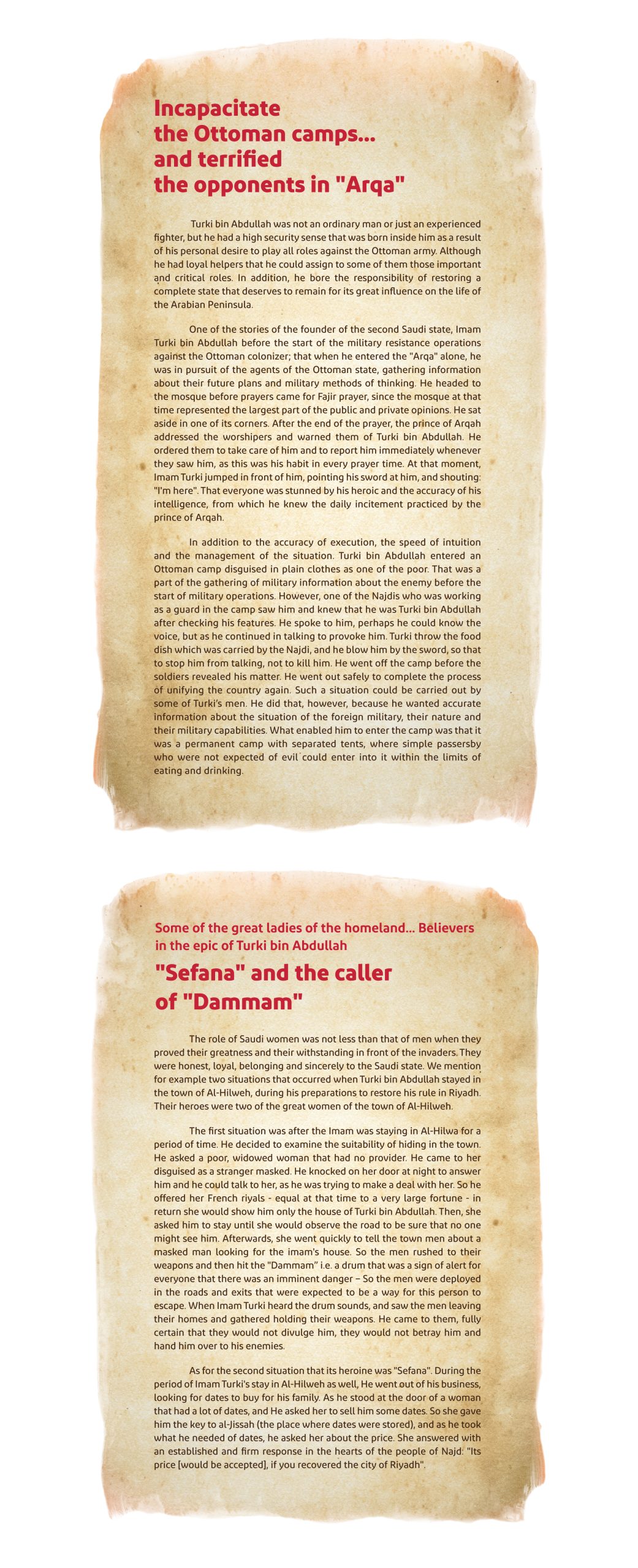


- Othman bin Bishr, Address of glory in the history of Najd, edited and commented by: Abdulrahman Al Sheikh, 4th Edition (Riyadh: Department of King Abdulaziz, 1983).
- Munir al-Ajlani, Imam Turki bin Abdullah Batal of Najd and its liberator (Riyadh: Al-Shibl House, 1990).
- Abdel Fattah Abu Aliya, History of the Second Saudi State, 5th Edition (Riyadh: Al-Merrikh House, 1995).
- Khalifa Al Masoud, the position of the opposing forces from the second Saudi state (Riyadh: Department of King Abdulaziz, 2005).





